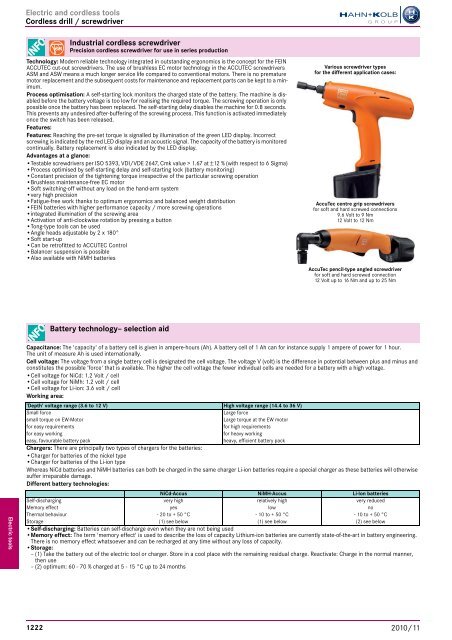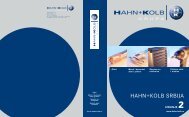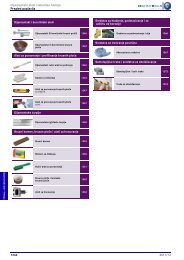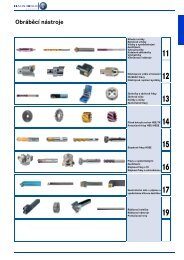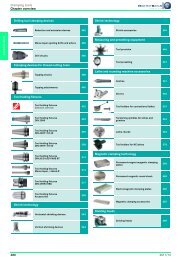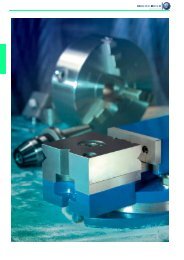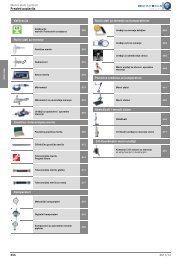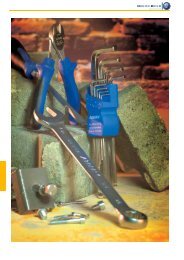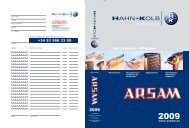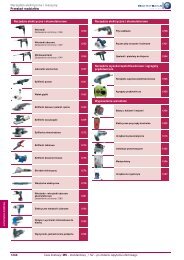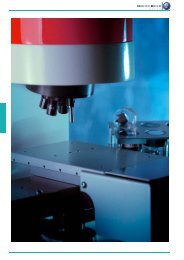Electro-tools and machines Chapter overview ... - EN / Hahn+Kolb
Electro-tools and machines Chapter overview ... - EN / Hahn+Kolb
Electro-tools and machines Chapter overview ... - EN / Hahn+Kolb
- No tags were found...
Create successful ePaper yourself
Turn your PDF publications into a flip-book with our unique Google optimized e-Paper software.
Electric <strong>and</strong> cordless <strong>tools</strong>Cordless drill / screwdriverContinued next pageIndustrial cordless screwdriverPrecision cordless screwdriver for use in series productionTechnology: Modern reliable technology integrated in outst<strong>and</strong>ing ergonomics is the concept for the FEINACCUTEC cut-out screwdrivers. The use of brushless EC motor technology in the ACCUTEC screwdriversASM <strong>and</strong> ASW means a much longer service life compared to conventional motors. There is no prematuremotor replacement <strong>and</strong> the subsequent costs for maintenance <strong>and</strong> replacement parts can be kept to a minimum.Process optimisation: A self-starting lock monitors the charged state of the battery. The machine is disabledbefore the battery voltage is too low for realising the required torque. The screwing operation is onlypossible once the battery has been replaced. The self-starting delay disables the machine for 0.8 seconds.This prevents any undesired after-buffering of the screwing process. This function is activated immediatelyonce the switch has been released.Features:Features: Reaching the pre-set torque is signalled by illumination of the green LED display. Incorrectscrewing is indicated by the red LED display <strong>and</strong> an acoustic signal. The capacity of the battery is monitoredcontinually. Battery replacement is also indicated by the LED display.Advantages at a glance:•Testable screwdrivers per ISO 5393, VDI/VDE 2647, Cmk value > 1.67 at ±12 % (with respect to 6 Sigma)•Process optimised by self-starting delay <strong>and</strong> self-starting lock (battery monitoring)•Constant precision of the tightening torque irrespective of the particular screwing operation•Brushless maintenance-free EC motor•Soft switching-off without any load on the h<strong>and</strong>-arm system•very high precision•Fatigue-free work thanks to optimum ergonomics <strong>and</strong> balanced weight distribution•FEIN batteries with higher performance capacity / more screwing operations•integrated illumination of the screwing area•Activation of anti-clockwise rotation by pressing a button•Tong-type <strong>tools</strong> can be used•Angle heads adjustable by 2 x 180°•Soft start-up•Can be retrofitted to ACCUTEC Control•Balancer suspension is possible•Also available with NiMH batteriesVarious screwdriver typesfor the different application cases:AccuTec centre grip screwdriversfor soft <strong>and</strong> hard screwed connections9.6 Volt to 9 Nm12 Volt to 12 NmAccuTec pencil-type angled screwdriverfor soft <strong>and</strong> hard screwed connection12 Volt up to 16 Nm <strong>and</strong> up to 25 NmContinued next pageBattery technology– selection aidElectric <strong>tools</strong>Capacitance: The 'capacity' of a battery cell is given in ampere-hours (Ah). A battery cell of 1 Ah can for instance supply 1 ampere of power for 1 hour.The unit of measure Ah is used internationally.Cell voltage: The voltage from a single battery cell is designated the cell voltage. The voltage V (volt) is the difference in potential between plus <strong>and</strong> minus <strong>and</strong>constitutes the possible 'force' that is available. The higher the cell voltage the fewer individual cells are needed for a battery with a high voltage.•Cell voltage for NiCd: 1.2 Volt / cell•Cell voltage for NiMh: 1.2 volt / cell•Cell voltage for Li-ion: 3.6 volt / cellWorking area:'Depth' voltage range (3.6 to 12 V) High voltage range (14.4 to 36 V)Small forceLarge forcesmall torque on EW-MotorLarge torque at the EW motorfor easy requirementsfor high requirementsfor easy workingfor heavy workingeasy, favourable battery packheavy, efficient battery packChargers: There are principally two types of chargers for the batteries:•Charger for batteries of the nickel type•Charger for batteries of the Li-ion typeWhereas NiCd batteries <strong>and</strong> NiMH batteries can both be charged in the same charger Li-ion batteries require a special charger as these batteries will otherwisesuffer irreparable damage.Different battery technologies:NiCd-Accus NiMH-Accus Li-Ion batteriesSelf-discharging very high relatively high very reducedMemory effect yes low noThermal behaviour - 20 to + 50 °C - 10 to + 50 °C - 10 to + 50 °CStorage (1) see below (1) see below (2) see below•Self-discharging: Batteries can self-discharge even when they are not being used•Memory effect: The term 'memory effect' is used to describe the loss of capacity Lithium-ion batteries are currently state-of-the-art in battery engineering.There is no memory effect whatsoever <strong>and</strong> can be recharged at any time without any loss of capacity.•Storage:– (1) Take the battery out of the electric tool or charger. Store in a cool place with the remaining residual charge. Reactivate: Charge in the normal manner,then use– (2) optimum: 60 - 70 % charged at 5 - 15 °C up to 24 months1222 2010/11


